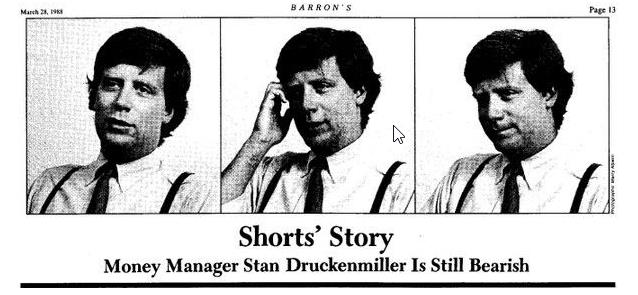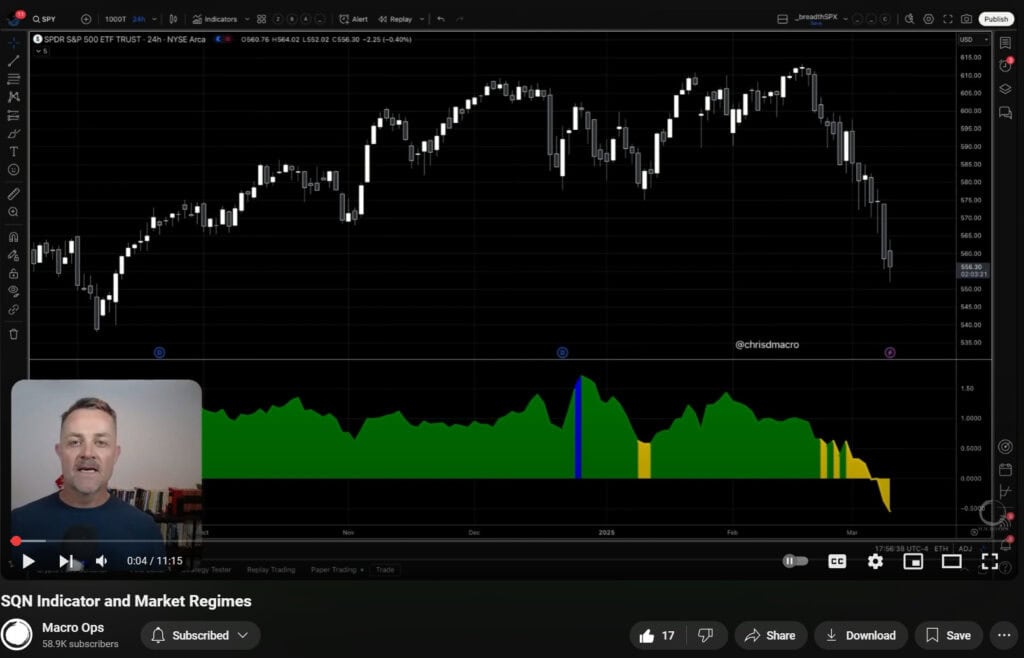What’s obvious is obviously wrong… The present is already in the price… And it’s margins and capacity that matter… ~ Stanley Druckenmiller
The following are some more words of wisdom from Druck pulled from an old Barron’s interview in 88’. There’s a few notes from me as well…
Gauging the macro environment through three different lens (emphasis by me):
We look at the market in three different ways — and each of them is flashing warning signals. First of all, we look at valuations. We use them to determine, really, the market’s risk level, as opposed to its direction… Valuation is something you have to keep in mind in terms of the market’s risk level… when catalyst’s come in and change the market’s direction… the decline could be very major if you’re coming from the kinds of overvaluation levels witnessed in ‘29 and the fourth quarter of last year (note: this was in the year following the 87’ crash). So valuation is something we keep in the back of our minds.
The major thing we look at is liquidity, meaning as a combination of an economic overview. Contrary to what a lot of the financial press has stated, looking at the great bull markets of this century, the best environment for stocks is a very dull, slow economy that the Federal Reserve is trying to get going… Once an economy reaches a certain level of acceleration… the Fed is no longer with you… The Fed, instead of trying to get the economy moving, reverts to acting like the central bankers they are and starts worrying about inflation and things getting too hot. So it tries to cool things off… shrinking liquidity… [While at the same time] The corporations start having to build inventory, which again takes money out of the financial assets… finally, if things get really heated, companies start engaging in capital spending… All three of these things, tend to shrink the overall money available for investing in stocks and stock prices go down…
Druck has also said:
Earnings don’t move the overall market; it’s the Federal Reserve Board… focus on the central banks and focus on the movement of liquidity… most people in the market are looking for earnings and conventional measures. It’s liquidity that moves markets.
This is absolutely true. Liquidity is a key metric we track at Macro Ops. It’s also the most misunderstood by market players. To read more on the topic of liquidity, check out this piece.
Also, this next line is so important to understand:
…the best environment for stocks is a very dull, slow economy that the Federal Reserve is trying to get going.
Once you understand how and why liquidity works, you’ll fully grasp the old Wall St. adage of “Don’t fight the Fed”. The Fed controls the biggest lever on global liquidity. And liquidity is what drives stocks… NOT the economy.
Think about the last eight years of the current bull market. Economic growth has been pathetic, inflation fleeting, and confidence in the direction of the economy dour. But at the same time we’ve experienced one of the largest and longest bull markets in history…
The pundits and fin-twit bears who’ve been shouting about impending doom and gloom, crying about how detached the market is from the “fundamentals”, don’t understand the most important fundamentals of them all: liquidity and sentiment.
The worse thing that could happen to this current bull market is for the economy to markedly pick up. That growth would spur inflation, which along with improved sentiment, would make the Fed a lot more comfortable tightening at a faster pace. Liquidity would then be pulled from the system and drive the stock market lower.
Don’t confuse the stock market with the economy. Understand that the market is forward looking and the biggest lever on future demand is liquidity. That’s why you need to understand the reaction function of the Federal Reserve.
On valuations and market moves:
In this century the stock market has tended to trade between 1.1 and 2.2 times book… And stocks generally yield between 6% or 7%. When people are feeling good about the world, for some reason, 2.1 to 2.2 times book and 3% yield tend to be the cap…
I do know that every time the stock market has gone down 30% in this century, we’ve had a recession. The only good economist I have found is the stock market. To people who say it has predicted seven out of the last four recessions, or whatever, my response is that it’s still a lot better than any of the other economists I know.
Concentrated bets and the importance of focusing on margins:
To try to add value to our portfolio, we make very concentrated bets in industry sectors, rather than simply being overweight or underweighted in terms of the S&P. If you look at our portfolios over time, four to five industries tend to represent 90% of the holdings — long and short… We choose these industries by trying to buy companies where we feel the margins are going to be higher in one to three years and selling companies where we feel they’re going to be lower in one to three years.
[In response to the question of why focus on margins?] It’s tied in with my liquidity argument. When corporate America is operating at very high rates, it starts building capacity, which sucks out liquidity; it also lowers companies margins two years out. And that’s the opposite of when a bull market starts…
With the longs, we are trying to identify situations where we feel that margins are going to be higher over the next year or two. We’re trying to identify industries that are operating at fairly low rates, which will be rising, but where you won’t see capacity increases for at least a couple of years, and where the profit margins will be much higher by then. [And] we don’t sell things just on a valuation basis… We need to see what is going to make the margins come down…
There are a number of important points here. Druck is noting the importance of trading off future outcomes in relation to current expectations instead of trading the present reality. In a talk at USC a number of years ago he said:
Too many investors look at the present, the present is already in the price. You have to look think of the box and sort of visualize 18 to 24 months from now what the world is going to look like and what securities might trade at.” What a company is earning right now doesn’t mean anything. What you have to look at is, what a company is earning and what people think it’s going to earn and if you can see something that in two years is going to be entirely different than the conventional wisdom, that’s how you make money. My first boss said “what’s obvious is obviously wrong.”
A useful tool for valuing potential future outcomes is the margins of sectors and industries. There’s a cyclicality in margins that provides a window into the point of the capital cycle a particularly industry or sector is in.
Fat profit margins attract competition. Competition leads to increased investment. Increased investment leads to glut and contracting margins until capacity is taken offline. And then the cycle begins anew.
Stanley Druckenmiller is among the greatest traders to ever play the game. His big advantage is that he understands liquidity and how it drives macro. And knowing macro is one of the most important keys to market success. As one of Druck’s proteges, Scott Bessent put it:
Recently, I was at a money manager roundtable dinner where everyone was talking about “my stock this” and “my stock that”. Their attitude was that it doesn’t matter what is going to happen in the world because their favorite stock is generating free cash flow, buying back shares, and doing XYZ. People always forget that 50% of a stock’s move is the overall market, 30% is the industry group, and then maybe 20% is the extra alpha from stock picking. And stock picking is full of macro bets. When an equity guy is playing airlines, he’s making an embedded macro call on oil.










